Crocheted with sturdy Omega nylon, this basket/bag will help you store and tote your stuff in style!
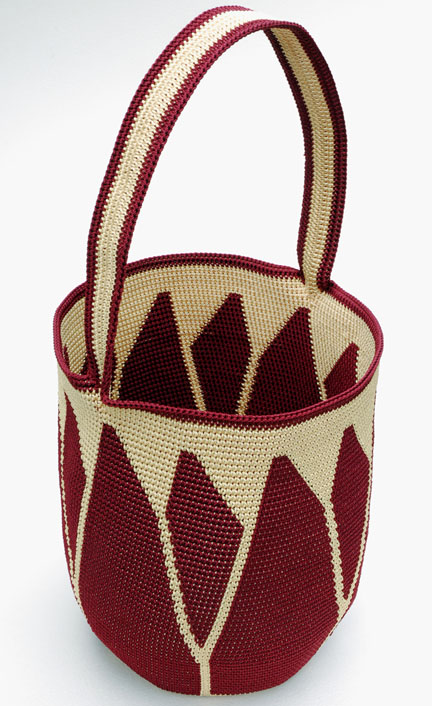
Flower Power Basket in Inside Crochet Issue 7
I hope you’ll get some flower power and give this project a try! This is no April Fool’s joke!
Crocheted with sturdy Omega nylon, this basket/bag will help you store and tote your stuff in style!

Flower Power Basket in Inside Crochet Issue 7
I hope you’ll get some flower power and give this project a try! This is no April Fool’s joke!
Siglinde inserts her hook into the back loop in the European manner. She started to crochet clothes for her dolls when she was a little girl. Siglinde’s motifs are inspired by Mexican, Indian and Scandinavian designs. She also modifies embroidery or knitting graphs and is constantly on the lookout for motifs on drapery, dishes, wallpapers, etc. She says there is inspiration everywhere 🙂
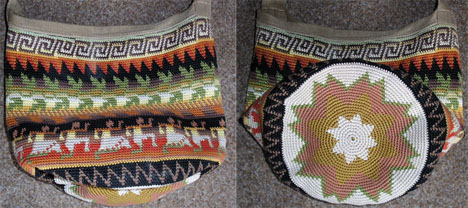
1990’s
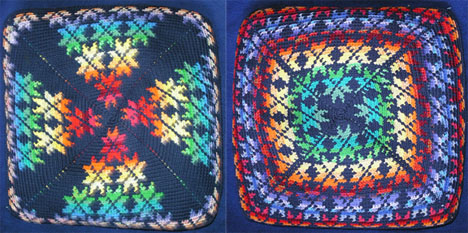
April 2006
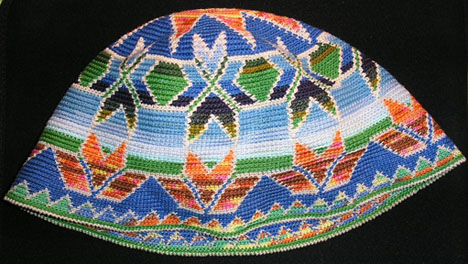
September 2006
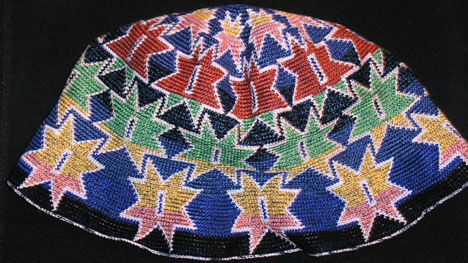
September 2006
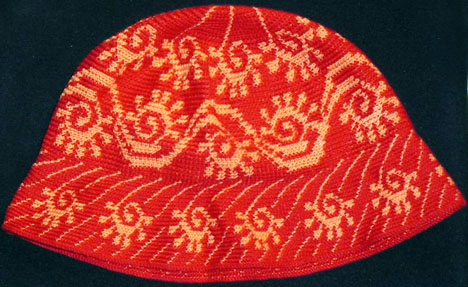
September 2006
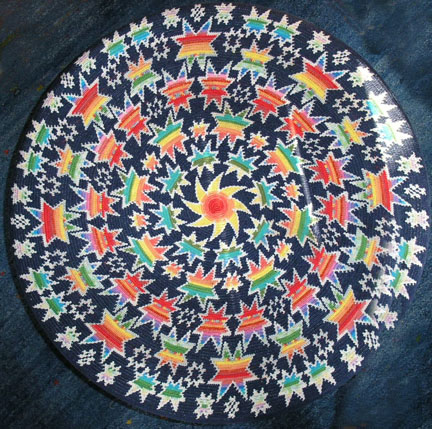
October 2006
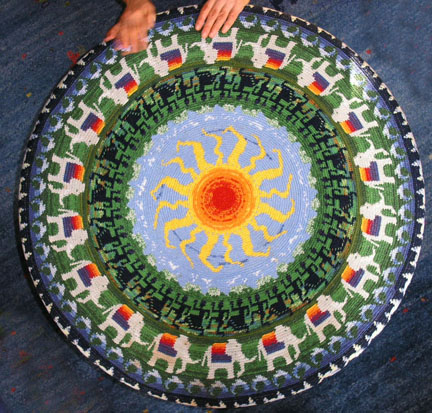
October 2006
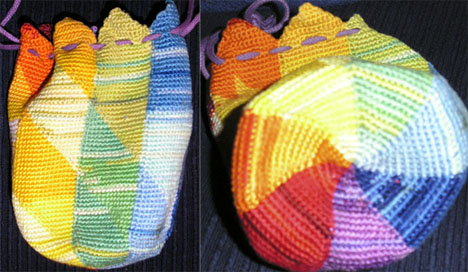
December 2006
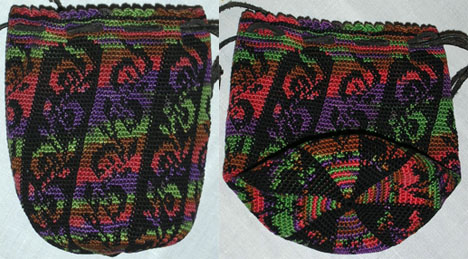
January 2007
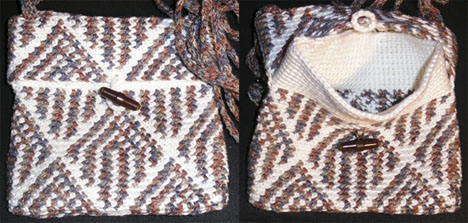
April 2007
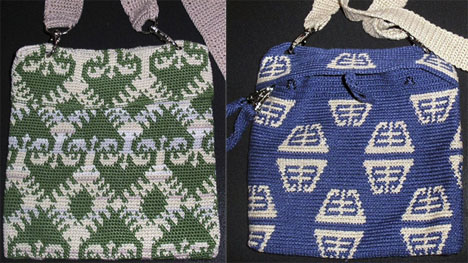
April 2007
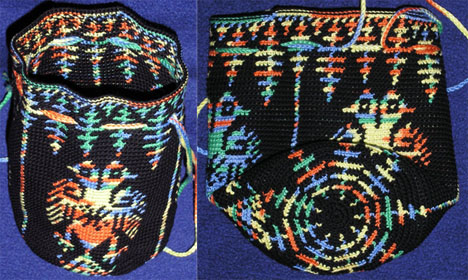
September 2007
Siglinde is a very private person, so we owe a depth of gratitude to her son for sharing his mother’s exquisite masterpieces with the world!
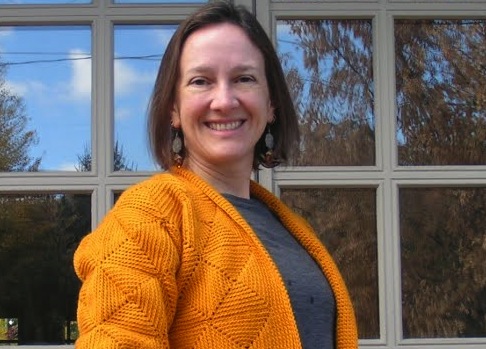
Pippi Konstanski of Pocatello, Idaho.
“I made the bag below sitting in the sun at a folk festival in Oregon. I found the earring part in the dirt, and incorporated it into the bag, as the triangle in the piece matched the ones on my bag.”
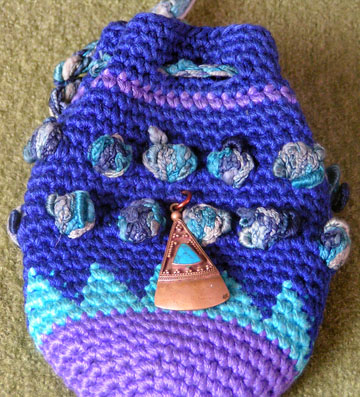
Bauble Bag, Summer of 1997
“The bag (below left) is the second bag made with this design. The first was in different colors, and was made as a gift for a friend. The bottom of the bag on the right was done in 4 colors spiraling together. The spiral was inspired by Celtic spiral designs, but the colors reminded me of Native American Indian designs, so I added the tassels on the sides, like the fringes they often added to their leather bags.”
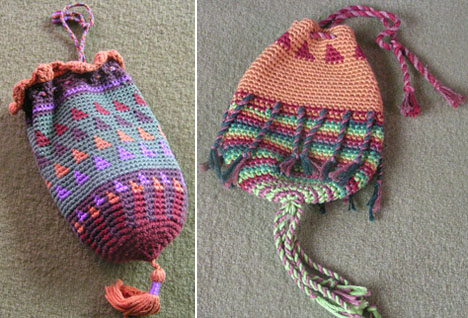
Triangles Bag, Spring 1998, and Spiral Bag, Summer 1998
“I made this bag (below) when my daughters and I went to Ireland for a bike trip. We flew into Heathrow on a bank holiday weekend, so we spent the weekend with some friends. Sharon and I went to a local church flea market, and I bought two skeins of hand spun and dyed wool yarn. Sharon had an extra crochet hook, which she gave me, and I used up both skeins to make this bag.”
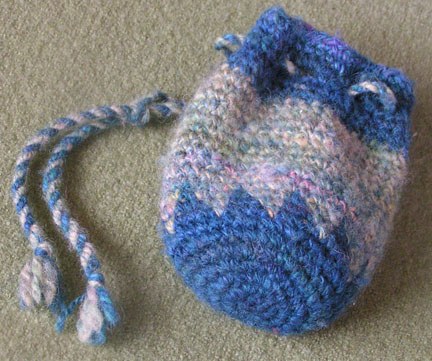
September 1998
“I made this little shoulder bag (below) for when I went out and didn’t want to carry anything but the bare minimum. I sewed Swarovski bicone beads in places for s bit of sparkle. Just another cute shoulder bag for myself.”
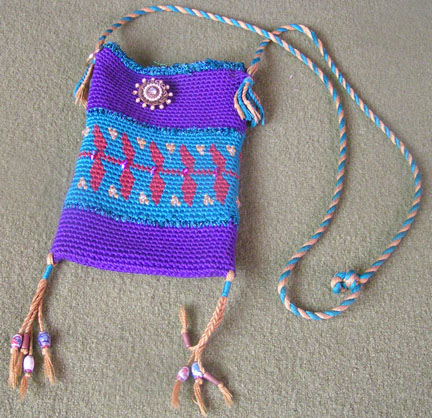
Pippi’s Bag, 8” x 5”, Spring of 1999
The beaded pattern on the next bag was inspired by a traditional Croatian embroidery design.
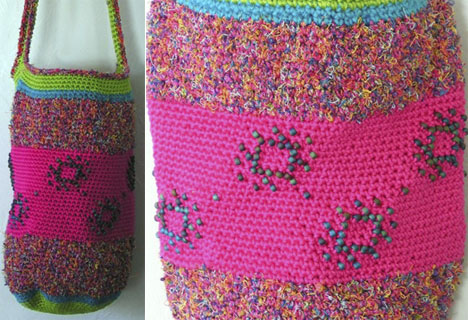
Bead tapestry crochet bag, March 2006
Pippi made the Sunrise Bag and the Chocolate Bar Bag (below) as a sort of a challenge. She bought a set of 20 skeinlets of different yarns from an Etsy seller’s shop, then tried to put them together into a meaningful pattern, using the mix of colors on hand, all of which were quite different. The triangle stone button on the Sunrise Bag is also from Etsy.
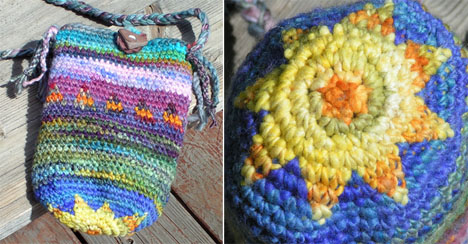
Sunrise Bag, 8” x 5.5”, August 2008
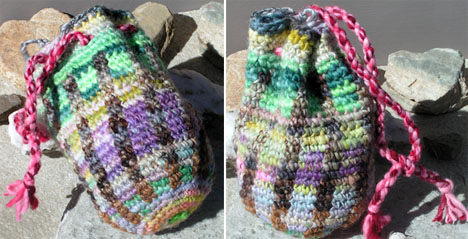
Chocolate Bar Bag, August 2008
The bags below were tapestry crocheted with yummy hand-dyed, 100% silk yarn from Etsy’s Hedgehogfibres.
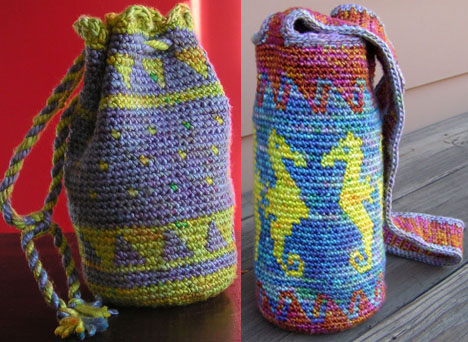
The 7” x 5” bag (left) dates to October and the 10″ x 7″ (not including the strap) Seahorse Bag dates to November 2008.
“I made this tapestry crochet purse with two straps, so I could wear it like a backpack when riding my bike. The flap was made with a piece of painted velvet I got from my friend Corona, who makes amazingly beautiful velvet hats.”
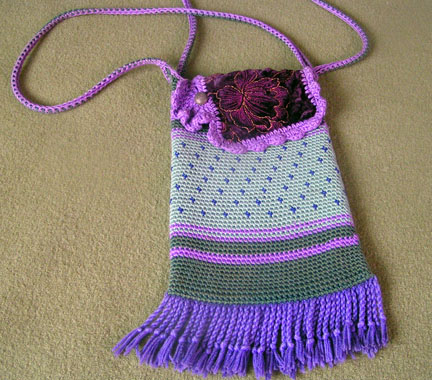
Pipi’s husband inspired the bags below. She explains, “I was making a bag for a friend of a friend, and asked what colors he liked, and my husband suggested a black bag with a red skull. “You can do that?” he asked? I started looking at pictures of real skulls, and designed this pattern”.
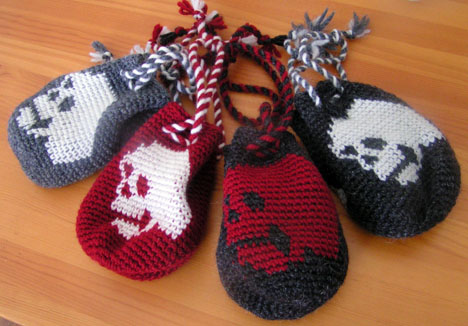
Skull Bags, each is 5.5” x 3.5, February 2009
“This bag (below) was inspired by the variegated yarn called Limbo Mexiko that I bought at The Loft. When crocheted in single crochet, it looks like serape material. I used tapestry crochet to insert my skull pattern into the design, then added crocheted roses under the skull, and a row of turquoise teardrops and two tiny bone skull beads above. The pattern is the same on both sides. I had just enough of the variegated yarn left to twist into the cord for the shoulder strap, and I added a scalloped fringe along the bottom of the bag to edge the design.”
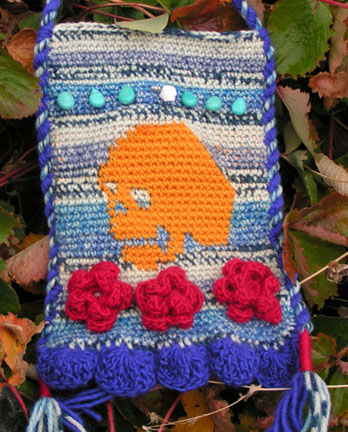
Dia de los Muertos (Day of the Dead) Shoulder Bag, October 2009
Pippi’s inspired by everything! She explains, “The shape and color of a tree leaf, the contour of the mountains against the blue sky, ancient mosaics, carved stonework on buildings, the ever expanding circles in a pool of water when a drop falls on it, needlework patterns, lichens painting a rock with bright colors. You name it!”
Pippi is also a talented jeweler. To see more of her creative work, just take a look at Flickr and Etsy and Facebook and she’s on Twitter, too!
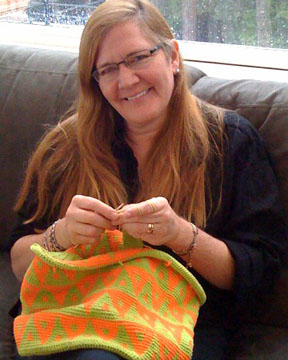
Betsy, La Guapa, tapestry crocheting.
Betsy was born in Los Angeles. Her a mother was from Bogota and her father was Norwegian. The family spent 6 years of her childhood in Colombia, and she later lived there with her grandmother for a year.
When I asked if la guapa meant “beautiful” in Spanish, she explained that she got that nickname after living in Spain for five years. In her own words, “It’s a very very common term in Spain and I used it often when I moved back to the states. Hence the nickname. Has little if anything to do with being beautiful. Spaniards use it all the time. It’s like saying, ‘Hi Sweetie.’ Guapo, the masculine version, is just as common.”
“I live in New York City and have been married to Gabriel, a Colombian from Medellin, for 10 years. We go back every two years or so. On one of those trips we stayed with one of Gabriel’s cousins. She was crocheting a huge bedspread using white thread. Wherever she went she took it with her. It was a wedding present for a friend. I was mesmerized. It was very Garcia Marquez. Wherever she went, she’d pull out this huge bag with the bedspread and just start crocheting while chatting away. I had quit smoking a few months before, and I thought crocheting would be a great way to occupy my time. So, when I got home, I bought a how-to book, and taught myself. I started making simple bags. And when I saw your tapestry crochet site, I realized that I could make a version of the Colombian ‘mochillas’ using tapestry crochet.”
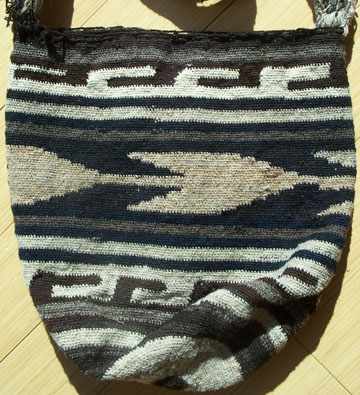
A looped mochila/mochilla bag from Columbia.
So it’s not surprising that Betsy’s motifs are based on the boldly patterned mochila/mochilla bags of the Arhuacos from northern Colombia. College students in Bogota use these bags like US students use back packs. Although described as being woven, crocheted, or knit, the Arhuacan bags are actually made by looping (pulling the fiber all the way through a small loop). The geometric patterns translate well to tapestry crochet.
Betsy likes to crochet with cotton and small hooks, sizes C, D, and E. The bag (below) was her first tapestry crochet bag.
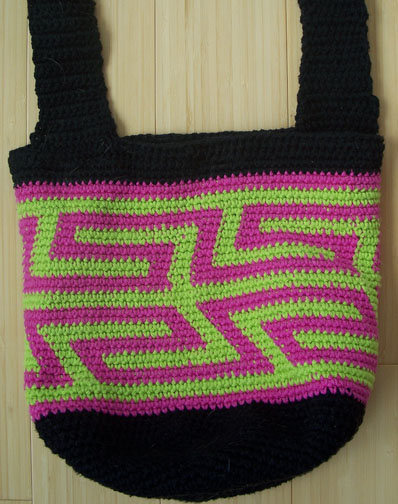
Betsy’s first mochila, tapestry crocheted with Lily Sugar’n Cream Solid, March 2008.
The bag below is her favorite – the one she uses every day.
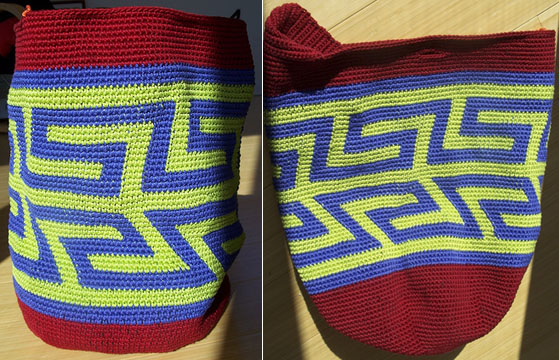
Tapestry crocheted with EL. D. Mouzakis Butterfly Super 10 in March 2009.
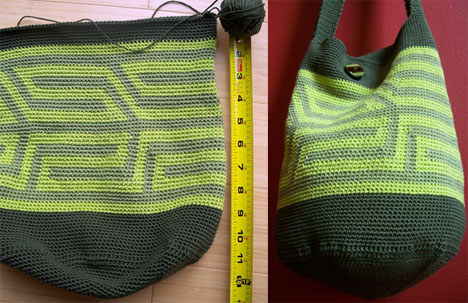
Andrea’s Mochila, tapestry crocheted with EL. D. Mouzakis Butterfly Super 10 in July 2009.
“I made this (below) for my sister who wanted a bag to go with jeans and whatever top she was wearing. I’m not thrilled with it because there’s not enough contrast in the two colors of the pattern. It’s more dramatic if there’s more contrast. It’s also not wide enough. I’d make the next one using this yarn 8” across the bottom. I started putting a little pocket on the inside of these bags for a cell phone. Otherwise you’re constantly fishing it out from the bottom!”
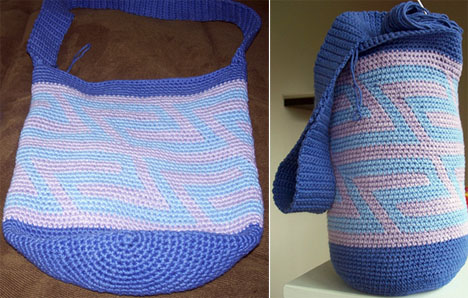
Nena’s Mochila tapestry crocheted with Lion Brand Lion Cotton Solid in August 2009 (7 x 13 x 26″ handle).
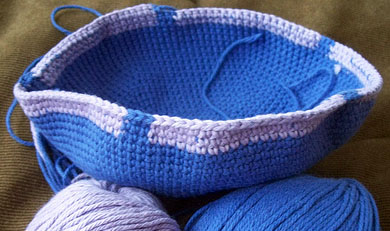
Nena’s new bag with more contrasting colors.
“I am not liking this bag (below) at all. The colors are horrible together! But there’s so much work in it already, that I can’t bear to tear it out… so I keep adding to it thinking it’ll get better… but it just gets uglier. I will eventually tear it out. The yarn is too pretty to not put it to better use.”
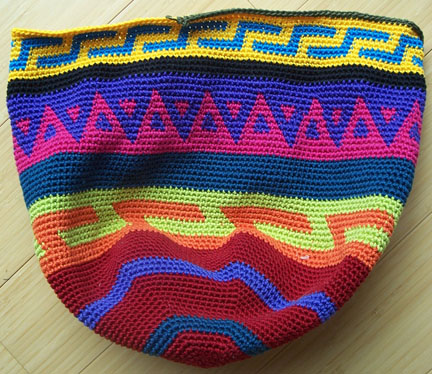
Betsy’s Icky Bag.
I love how Betsy has incorporated her heritage into her work and I think that her nickname is very appropriate because both she and her tapestry crochet bags are beautiful! I don’t think her Icky Bag is so bad, either!
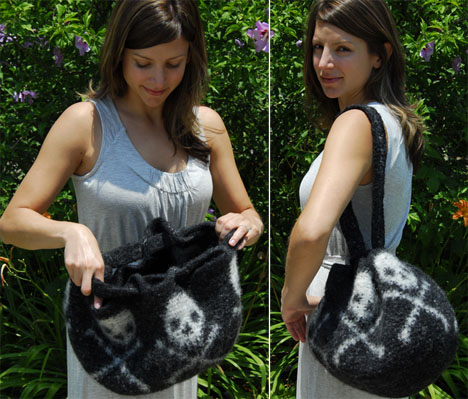
Felted Tapestry Crochet Bag for Right Handed and Left Handed crocheters.
This bag is loosely tapestry crocheted with Lion Wool and a size K hook. The bag shrinks and felts like magic in a washing machine. The loose stitch makes it a fast project to crochet and a great first tapestry crochet project, too! For more about my interest in skulls, you might enjoy reading my UFO Bag blog.
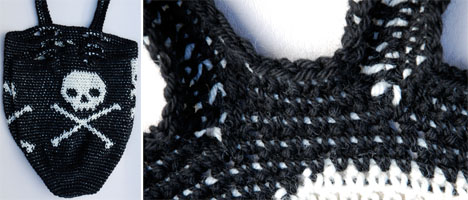
The bag (with handle detail) before it was felted in the washing machine.
The skulls and crossed bones are visible on the inside and the outside of the bag – and since I liked the inside better after it was felted, I turned it inside out! The felted fabric is so substantial, it doesn’t need to be lined.
Why am I telling you about this bag now? Well, I just realized that I never blogged about it AND I realized that this pattern would be the perfect last minute gift since it’s downloadable – actually one of several tapestry crochet patterns that I sell online. Just scroll down the sidebar on the right to see them all!
Happy Holidays!
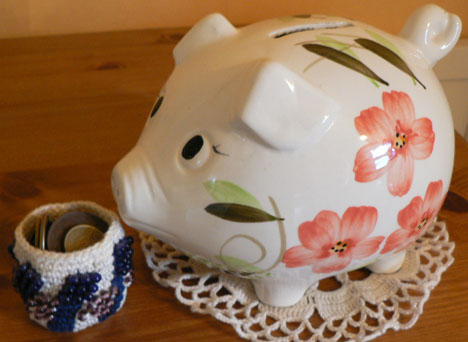
Iiro’s been eating from his bead tapestry crochet basket since 2005!
Barbro explains, “I think I did my first tapestry crochet when I crocheted/knitted a Korsnäs sweater in the early 80’s. Since then I have crocheted a few (giggle) purses and bags (more giggle). Yes, I love tapestry crochet, and thanks to Carol I learned how to add beads. I mostly crochet by simply casting on and see what will happen. That means I keep unraveling a lot.” 🙂
The sweater below was “Knitted / crocheted at Marketta Luutonen’s first workshop in Vasa in the 80’s. This traditional sweater was made for men in the 19th century, in the 20th and 21st also for women. Nowadays they are often changed into cardigans. Note that the tapestry crochet is worked in the back loop.”
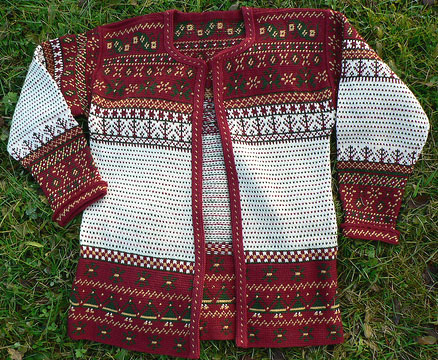
Knitted and tapestry crocheted (into the back loop) wih Novita Marimba wool in 1984.
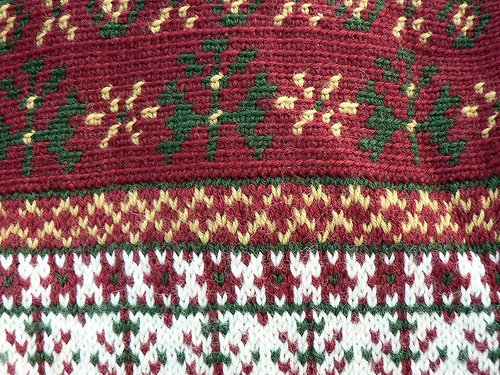
Detail of the sweater’s crochet and knitting.
“This bag (below) is perfect when I walk around the house doing things. I hang the purse around my neck.”
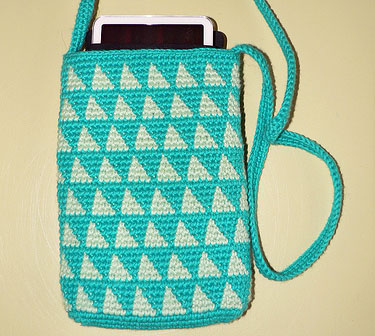
Tapestry crocheted with Sandnes Garn Mandarin Petit cotton in August 2007.
The bag (below) was “Improvised from Carol Ventura’s patterns in her book, More Tapestry Crochet. I can’t resist crocheted shopping bags and purses. This will be big enough to keep a few books and all the necessary things i.e. lipstick, pen, keys, wallet… Bird from Vibeke Lind’s “Sticka efter gamla nordiska mönster.”
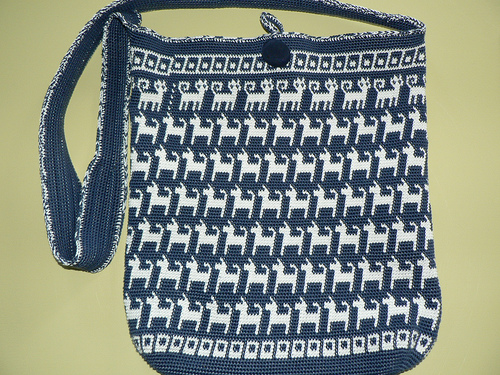
Tapestry crocheted with Novita Kotiväki cotton in July 2008.
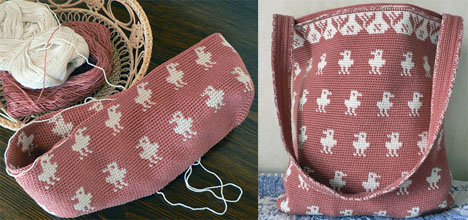
Barbro’s Bird Bag crocheted in April-May 2009.
“I do have to make a purse for my favorite spindle, don’t I??”
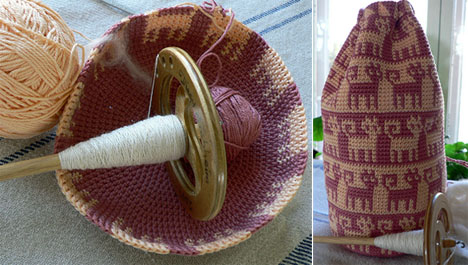
Tapestry crocheted in April 2009.
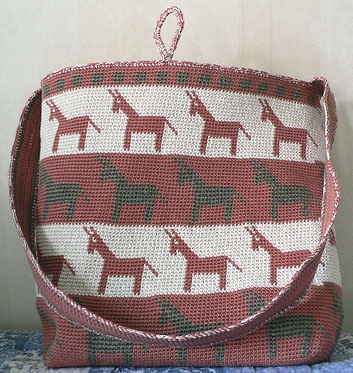
Tapestry crocheted cotton and linen Horse Around Purse, May 2009.
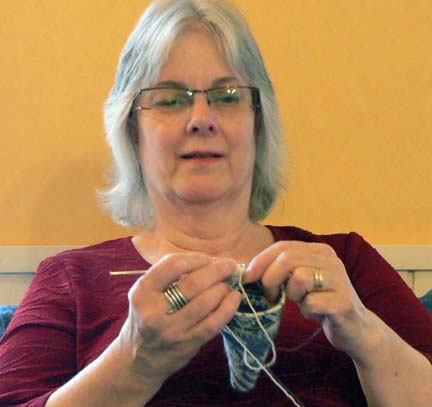
Barbro tapestry crocheting a cover for her spindle.
“My spindle, Precious (born at Journey Wheel), needed a cozy little home. I stole some elements from the Korsnäs sweater and crocheted them into both loops (traditionally worked into the back loop). I can’t resist the S-slinga (S-arabesque, festoon, creeper or whatever you prefer), so I use it quite often. The dancing girls are also fun to crochet. Bead crochet is a joy. I learned the technique at Carol Ventura’s workshop. I finally found a nice way to use a few meters of my handspun variegated merino-silkyarn, leftover from mother-in-law’s shawl.”
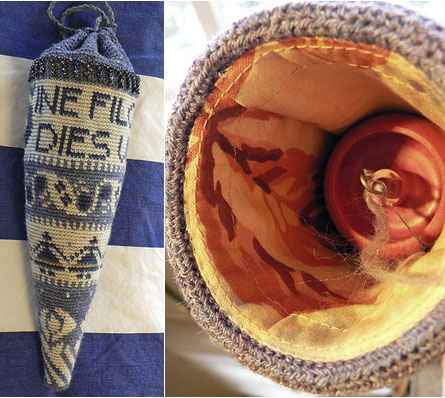
Not one day without a thread / Sine filo, nulla dies unum spindle holder crocheted in November 2009.
How did she do it? “Well, first you have to count your stitches. I had about 88 in the round, and the letters were planned to be 6-7 rounds high. I started to sketch in Excel, using colors close to my yarns. Carol Ventura has a great graph paper in her book More Tapestry Crochet, but I didn’t have it with me that day. I soon saw I had to crochet the text in two lines. I spread out the text to look balanced and started to crochet. It was GREAT fun!”
“I bead crocheted the rim, sew an inner lining, started thinking about how to close the purse. A casing was easiest to make. And Precious could go to bed in its new home!”
What will she be doing next? “Thanks to audio books that are now available everywhere, I will most certainly crochet more. I can’t tapestry crochet and read books simultaneously, which is what I do with knitting, lace crochet, and this autumn also spinning. My handspun merino-silk yarns are perfect for many projects: small purses, fingerless gloves etc. Maybe I’ll also start sketching own patterns, but that’s uncertain because of all the wonderful ethnic designs from all over the world that can be used.”
Are you hooked yet? If so, you can see more of Barbro’s work on Ravelry and you’ll want to follow her blog.
His introduction to tapestry crochet is quite interesting. Joel explains, “It all started when I read the book, Snow Walker’s Companion, by Garrett and Alexandra Conover. They have winter camping skills in the book and told and showed some “Chimo” hats which I later found out are called Pang or Nasaq or Nassak made by the Inuit. I looked them up on the internet and found some for sale but thought they were kind of spendy. Now I think different.”
“Being laid up from a spine surgery I thought I would learn to crochet and see if I could make one. I’ve messed with string before – being a rancher it is everywhere. Bale twine to ropes for ranch work. I have also braided for a long time so I thought it was just another string (yarn).”
“I went to my county Extension Home Economist and got a pamphlet on crochet for 4-H ers. I also bought a learn crochet book at The Yarn Stash in Minot, North Dakota, and away I went. Little did I know. I am left handed but I decided to bite the bullet and learn right handed because I thought it would be easier down the trail. I started my quest in November of 2008.”
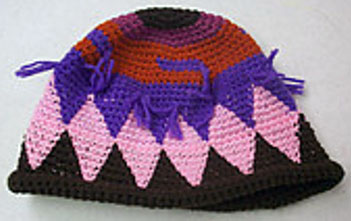
Joel’s first tapestry crochet attempt in January of 2009.
“My Mother had some old acrylic yarn and that is what I started out with. I have since found out wool is nicer. I found tapestry crochet information on the web and watched the videos and asked more questions. I got some graph paper and drew my own designs on some and used some charts from other sources.”
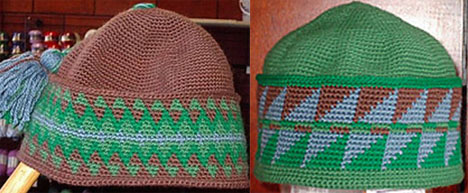
Joel’s second and third Nassak style hats, Plymouth Yarn Encore Worsted, 2009. He realized that, “The top (left hat) turned out better with the new increase tech I used with Shayne39’s advice. I figured out how to make one square edge on the design on this one (right hat).”
“Yarnfloozie (the Yarn Stash owner) got me hooked up with Ravelry which has been a good thing. I asked questions of lots of Ravelry people while I learned. Then I found out the hats were done in what was called tapestry crochet or stranded or intarsia I still have questions about all the terminology. Just a few weeks ago I found out about using the front loop or back loop only. Looking forward to trying that out.”
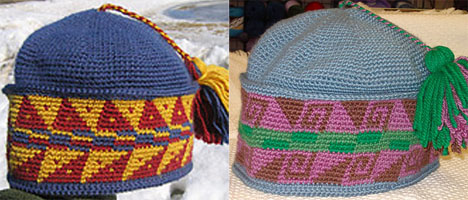
Joel’s fourth (March 2009) and fifth (May 2009) Nassak style hats. His instructions for the left hat are posted to Ravelry as a free download.
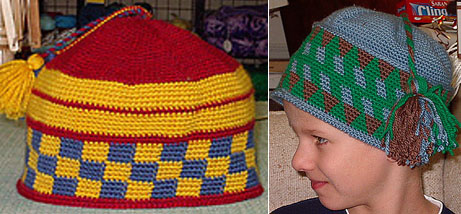
Joel’s hats made with Brown Sheep’s Lamb’s Pride Super Wash, April 2009 (left) and Patons Decor (right)
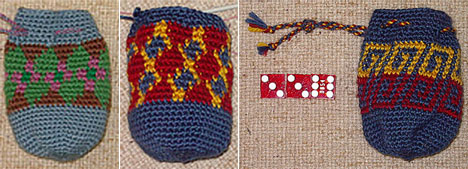
Joel’s Dice Bags, tapestry crocheted with scraps of yarn, August 2009.
“I am still learning. Yarnfloozie told me to enter some of my projects in the North Dakota State Fair, so I entered my first wool Nassaq just for fun. I didn’t think I had a chance but was flabbergasted when I got a blue ribbon. Also a white ribbon on a felted solid color hat.”
Joel described the next four hats on his Ravelry project pages: “Parts of the geometric pattern (lower left hat) are from Salish Indian Sweaters by Priscilla Gibson-Roberts (photo by Yarnfloozie), it is hat two for the Bible Camp auction.”
“Pi r round… cornbread r square. This was nice yarn only a little short in length. Only had about 18 inches left. First time using a multicolored Wool Yarn. Finished off with a crab stitch. I thought the numbers could have showed better till I saw it from a distance and it worked. Started with an increase of 5 for awhile then went to 7 and then back to 5 as I got done with the top getting more dome shaped. I hope this intimidates the crowd at Wednesday night trivia at The Blue Rider.”
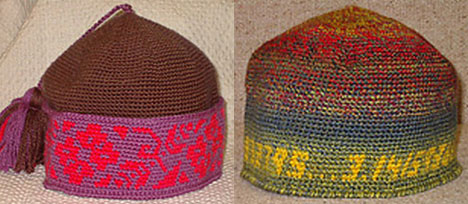
Nassak style hat (May 2009) and Pi Hat, Brown Sheep Nature Spun worsted wool, September 2009
“I saw Absinthia’s Mobile Phone Pouch and had to smile. Here in North Dakota we have some turkey buzzards. They are amazing fliers and you usually have to look into the sun to see them. Also it reminded me of a cartoon in a magazine I saw once of two buzzards sitting in a tree and one says to the other, ‘Patience my ass I’m going to kill some thing.’ So that is why I had to make this hat (lower left).”
“Did a different increase sequence (lower right hat) and liked it better 5 stitches per round, then started staggering the increases part way down. I think this bird could be Big Bird’s evil brother 😉 ”
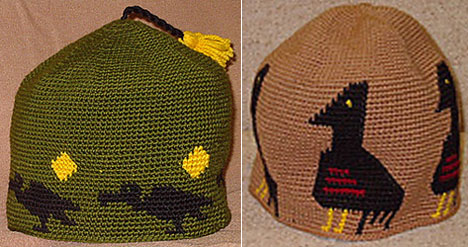
Both hats were tapestry crocheted in August of 2009 with Brown Sheep Nature Spun worsted wool.
“Here is some thing I have found out since I learned how to crochet. I have worn some of my hats and people stop me and ask me about them and where I got them. I tell them I made them my self after learning to crochet and some give me the stink eye like they don’t believe me but it is fun and makes one feel good. Now that I know a little more than I did a year ago I will stop some one and ask if they are wearing something they made them self. I can tell the difference now. 😉 ”
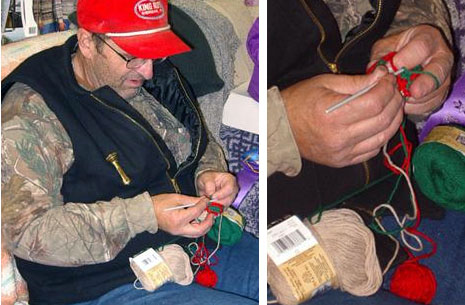
Joel tapestry crocheting a hackey sack at The Yarn Stash, “Just making it up as I go along out of crochet cotton.
To see more of Joel’s great work and other tapestry crochet designs, check out what’s going on in the Tapestry Crochet groups at Ravelry, Facebook, and elsewhere!
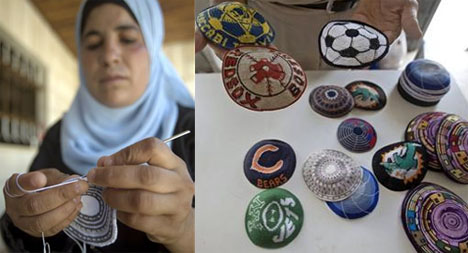
Palestinian tapestry crocheter and kippah
The short piece says that women in villages like Deir Abu Meshal on the West Bank have been producing religious headgear for their Jewish neighbors (and for export to the US) for years. The women told him that they enjoy making kippah while talking to each other and can tapestry crochet five a day. At $3 each, that’s only $15, but money goes further there than it does in the US.
Isn’t it wonderful that tapestry crochet not only helps put food on their tables, but also brings people together?
“Tapestry crochet caught my imagination instantly. The design possibilities are endlessly fascinating. I always like media that allow me to make pictures. Sooner or later I always want to make a tree and some creatures. Images that are somewhat representational and wholly fantastical seem to be indigenous to tapestry crochet, which suits me very well.”
“I played with tapestry crochet some when I first saw Carol’s book, and got sort of obsessive about it maybe two years ago. I seem to have 20-30 pieces around, and at least as many again have been given away. They tend to be in series; each one sort of fixes things from the previous one that I realize I could have done differently – or lets me try out things that I think of in the course of working the one before.”
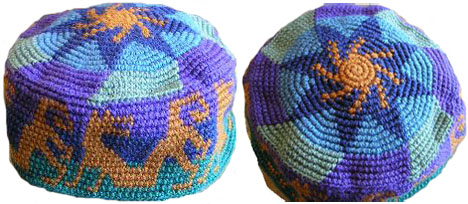
Cap, commercially dyed Dragon Tail 4/2 cotton, Summer 2007
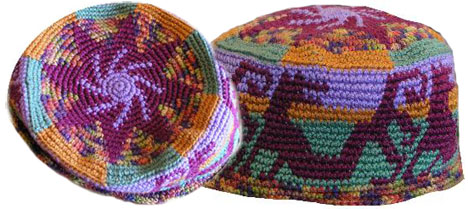
Cap, commercially dyed Dragon Tail 4/2 cotton, Summer 2007
“At first I made a lot of pouches and bags, but eventually settled into making more-or-less circular pieces. I find that eight increases per round make a spiral lie flat. (With plain single crochet, it takes six, but these stitches are a little bit taller, because of the carried strand, so the circumference grows more each time around.) I usually stack the increases, so that my pieces tend to have eight sections, divided radially (with a slight spiral), and finish as soft octagons. (The centers are often the same “pinwheel” design, which spirals the increases around faster.) At first I used the same design repeated all the way around, most often alternating a pattern and its mirror image. More recently I have used four design units in each piece, each one mirrored once, ending up with overall bilateral symmetry.”
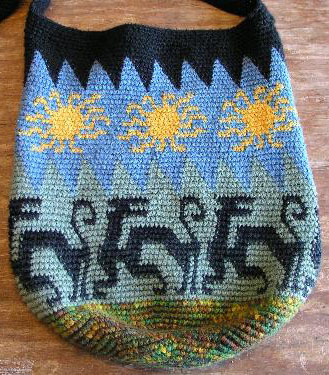
Bag, black and hand dyed and commercially dyed 4/2 cotton, Fall 2007
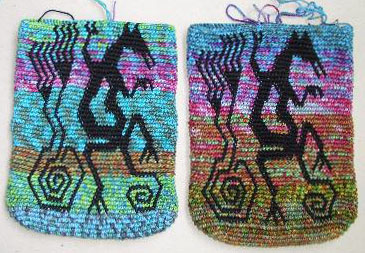
Kokopelli / Seahorse Bags, black and hand dyed 4/2 cotton
“I used Carol’s graph paper for a while, but my stitch/row ratio and skew were a little bit different. Since I almost always use the same yarn and hook, I made a digital picture of a piece, and worked up graph paper that matched it. Since I generally mirror the designs, I cheated just a little and off-set the rows 50/50. I don’t usually draw out the mirrored image, but read the pattern right-to-left, then left-to-right. I expect that doing this will help to stave off Alzheimer’s, or at least be very good practice for something.”
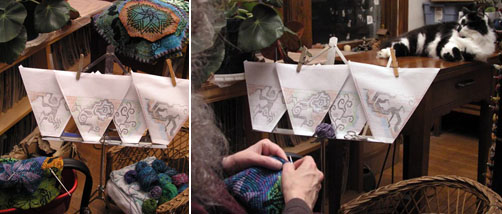
Crocheting Silver Apples of the Moon with her ingenious setup.
“For geometric pieces, it couldn’t matter less, for more or less representational pieces a closer match helped. I actually took a picture of a piece, put it on the computer and drew on top of it in a graphics pattern to get my proportions. Since I have been using the same yarn all the time, I just did it once.”
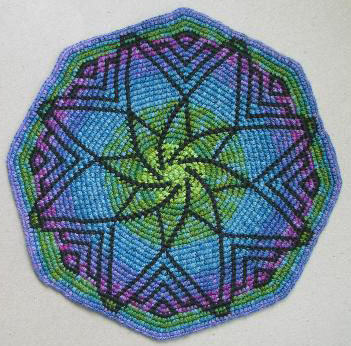
Water Lilies, black and hand dyed 4/2 cotton, 14″ diameter, Spring 2008
“Virtually all the tapestry crochet I’ve done has been in the same yarn; a 4/2 (about sport weight) mat cotton, with a #1 (2.75mm) hook. The black is commercially dyed (Dragon Tale), the rest is hand-dyed. I dye by direct application with Procion MX dyes. My dye-skeins are about two yards around (36 turns, or 72 yards), loosely chained and tied head-to-tail. I apply the dye thickened with sodium alginate from squeeze bottles. (I can estimate more accurately whether I have enough of a color or color-set if all the skeins start out the same size. An ounce of 4/2 has 100 yards, a yard does about 20 stitches.)”
When I asked Esther if she had a hand in naming Earth Guild’s Dragon Tail thread, she explained, “I have been drawing ads and general graphic presentation for Earth Guild since I joined the group in about 1973. At that time we had a bookstore called “Grateful Union”, as well as Earth Guild. When we started to do mail-order, it was under the name Earth Guild/Grateful Union Mail Order Service, or EGGUMOS. This sounded to me like the name of Ouroburos, or, more generally, some sort of dragon. Dragons, which I like to draw, appeared from then on most Earth Guild pictures. Many years later, when we started to put together a set of yarns, and were casting about for a name, we settled on Dragon Tale. BJ’s suggestion, sort of a pun (Tale/Tail).”
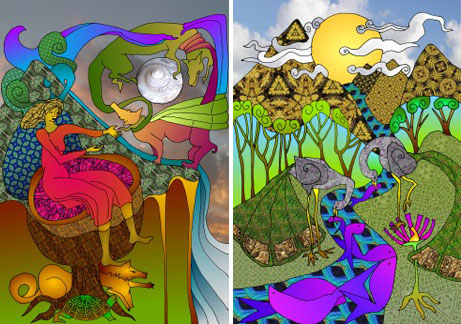
Esther’s Persephone and Herons.
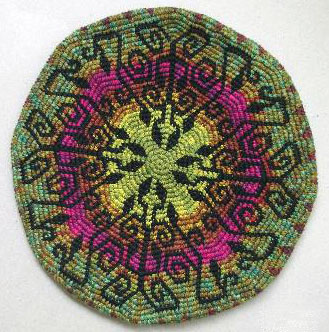
Beret, black and hand dyed 4/2 cotton, Summer 2008
The large piece below with yin yang – like motifs was commissioned for the center of the ceiling of a yurt-like building. Esther traded it for acupuncture treatments.
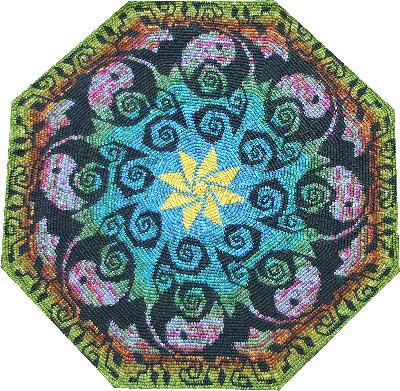
Untitled, black and hand dyed Dragon Tail 4/2 cotton, 27″ wide, Spring 2009
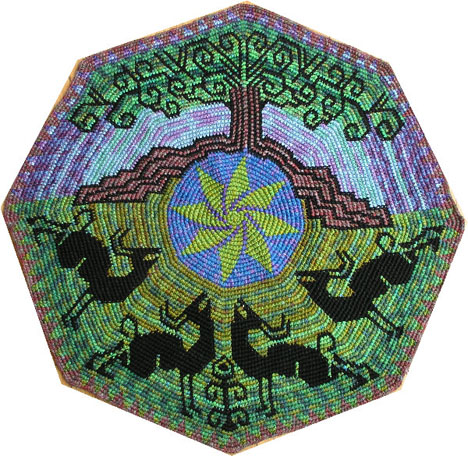
The first of Esther’s Tree Series: Baying, black and hand dyed 4/2 cotton, 20″ wide, Summer 2009
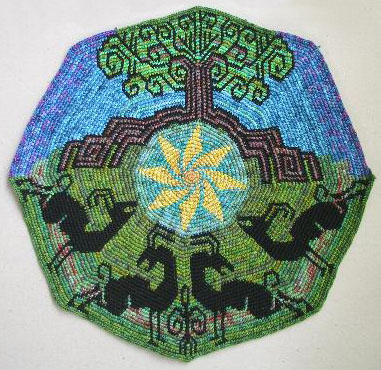
Baying, black and hand dyed 4/2 cotton, 20″ wide, Summer 2009
“Inspiration I don’t really know how to address. It seems like sooner or later, in any medium, I start trying to generate the same sorts of images, vaguely mythological, a little less vaguely “nature” based. They seem like they are already inside me, looking for different ways to emerge. Attached are pictures that I made, they seem related to me.”
“I generally do more or less the same thing with changes till I am more or less satisfied with it.”
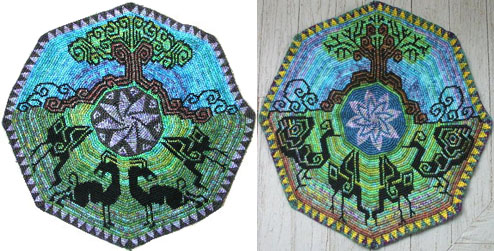
Esther also tapestry crocheted both of these this summer.
“I have included a picture of the back of the one with so many background color changes, just for the sheer horror of it. The ends, of course, just get clipped off (even that takes a while), but I like to do it after the piece is washed, in case they pull in a little.”
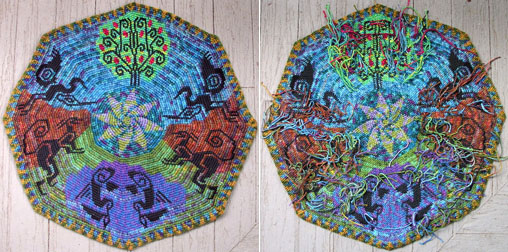
Front and back of Tree of Life, tapestry crocheted Summer, 2009.
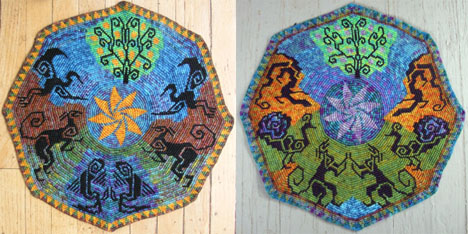
Esther’s Golden Apples of the Sun and Silver Apples of the Moon tapestries, each is 20″ wide, 2009.
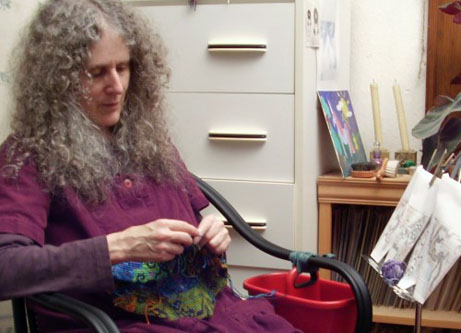
Esther Holsen tapestry crocheting Silver Apples of the Moon at home.
“The one (below) is an effort to use up bits and pieces, and to have something I could carry around, requiring fewer little balls of cotton and no graphs.”
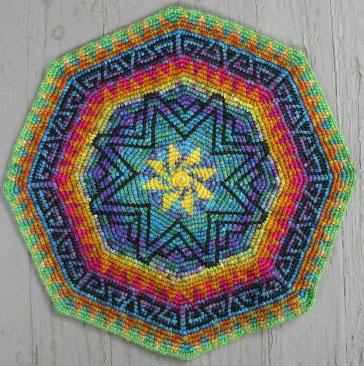
Esther finished this a few days ago.
Esther says, “I’m not sure where to go from here, I’m nowhere near through playing with this stage.”
I love what Esther has done already and REALLY look forward to seeing her next pieces. I usually don’t join the debate of, “Is it art?” or “Is it craft?” but Esther’s curiosity, talent, and motivation have propelled her across the line from craftsperson to artist, don’t you think?
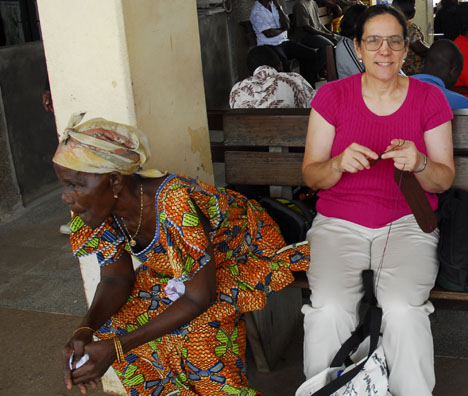
I started to tapestry crochet a bag with size 18 Omega nylon in the airport, then worked on it while waiting for the bus to Kumasi. This is how I looked after being awake for 24 hours – and I still had a 7 hour bus ride to go!
I was on the lookout for crochet everywhere! I didn’t see many examples, but did see some women wearing black net-like double crocheted hats and a few men with colorful single and tapestry crocheted hats.
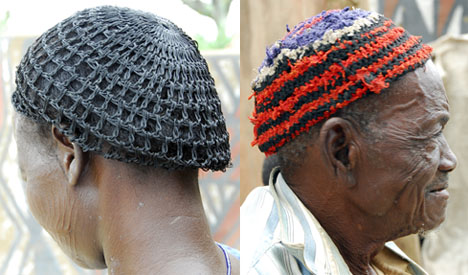
Double and single crocheted hats in Sirigu.
Many Muslim men in Ghana wear tapestry crocheted hats. I spotted the gentleman below in Krofofrom while researching lost wax casting.
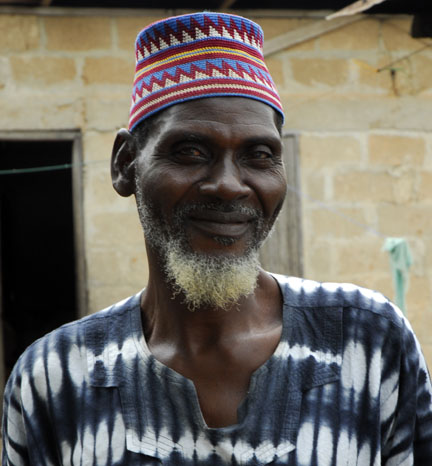
This Muslim man from Krofofrom told me that his hat was crocheted in Bogo, Ghana.
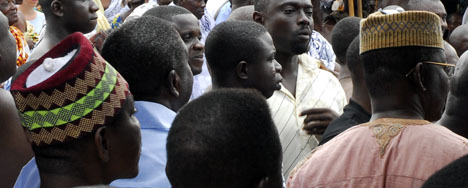
Fabulous imported tapestry crocheted hats worn in Kumasi.
A traveling salesman in Bolgatanga was selling both embroidered and tapestry crocheted hats. Guess which ones I bought?
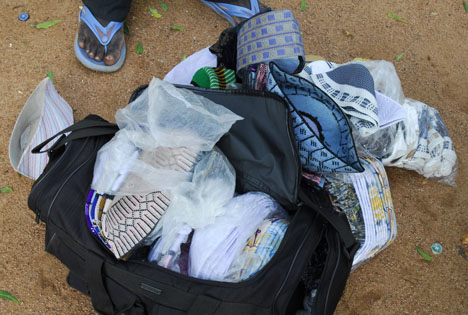
Embroidered and crocheted men’s hats for sale in Bolgatanga.
While researching adinkra in Ntonso, I taught four members of the THREAD group how to tapestry crochet a cell phone bag. They learned how to double crochet in school with thread and small steel crochet hooks, but didn’t know the single crochet stitch, so it was a challenge for them to do the new stitch, carry the other thread, and change colors with a larger hook – but they eventually got it!
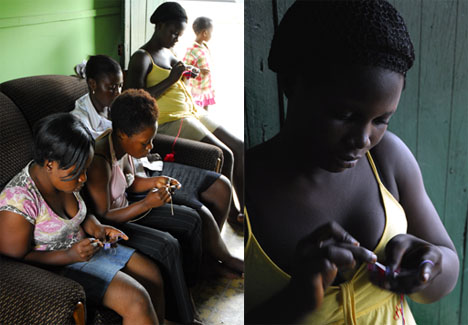
Women learning how to tapestry crochet a cell phone bag in Ntonso.
I was so busy the 3 weeks I worked and traveled in Ghana that I didn’t make much progress on my own bag. While waiting for the bus to bring me back to Accra, Arden approached me to ask what I was doing. I was so thrilled that she was interested that I gave her a mini lesson! She also learned just the double crochet stitch in school. After showing her how to single crochet and change colors, I handed her my bag and she gave it a try.
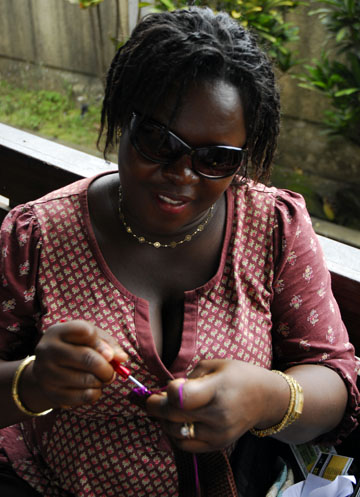
Arden gives tapestry crochet a try.
So I planted a few more tapestry crochet seeds in Ghana. Hopefully, they will take root and the next time I go to Ghana I will not have such a difficult time finding tapestry crochet!
My classes were small, so everyone received lots of individual attention and most managed to finish their projects during class. My Bead Felted Bag class was Thursday morning, then in the afternoon I taught how to design tapestry crochet motifs and projects.
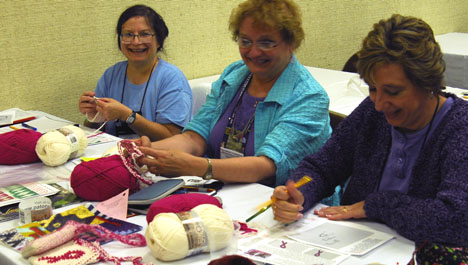
Pam Oddi, Delma Myers, and Caroline Brocato during the bead felted tapestry crochet class.
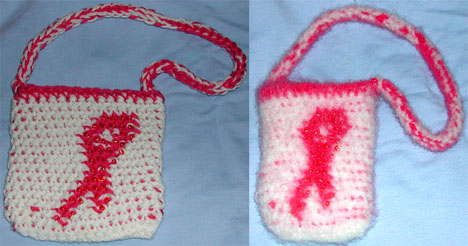
Sheryl Coleman’s bag before and after she felt it in her washing machine.
I usually include a short motif design lesson in my tapestry crochet classes, but it was REALLY NICE to be able to focus on design for 3 hours in the afternoon. Although I remembered to take pictures in the morning, I forgot about it during the Tapestry Crochet Project and Motif Design class. So close your eyes and imagine everyone with pencils in hand, drawing on their tapestry crochet graph papers – because that’s the picture I would have taken.
The Bead Tapestry Crochet Bracelet class lasted all day Friday. It’s the first time I’ve offered this class and I’m glad it was scheduled for 6 hours – because we spent the morning beginning the bracelets and the afternoon finishing them. It was quite a challenge for most to work with a small hook AND to remember to carry the extra color AND to switch colors before the stitch was finished AND to slide a bead into place before finishing the stitch.

The bead tapestry crochet bracelet class.
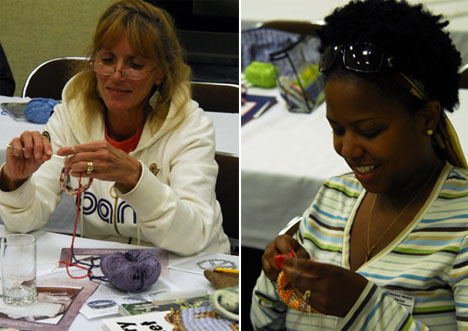
Cindy McMasters and Tina Thompson bead tapestry crochet their bracelet.
Not everyone competed their project, but most did and a few emailed me photos of their finished bracelet after the conference.
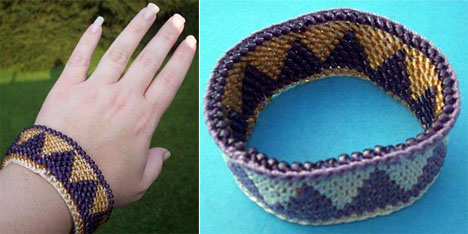
Adrienne Donner restarted and finished her bracelet at home.
One of the highlights of the conference for me was the Member Dinner and Fashion Show and this year CGOA celebrated their 15th anniversary – so it was really special – cake and all!
I usually volunteer to be a model to not only show off my own designs, but to also showcase the designs of others. This year, though, there were more than enough models, so I only modeled my New World Sweater. My talented roommate at the conference, Donna Childs, took the picture below of me on the runway.
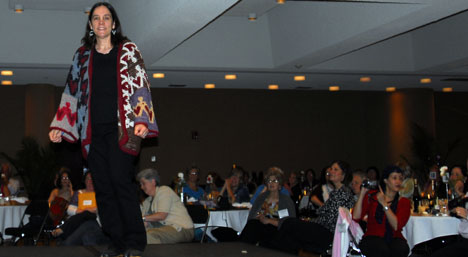
My New World Sweater in the Fashion Show
That picture reminds me of another thing I enjoy – sharing a bedroom with another crochet enthusiast! It’s a great way to get to know someone and I’ve been very lucky! Fortunately, we’ve always been very compatible.
And guess what? If things weren’t great enough, my Harvest tapestry won second place in the Crochet Art Category of the Design Contest! It earned a ribbon and $200 from Interweave! Other prizes were donated by Coats & Clark, Boye Needle Company, DRG, and Martingale & Company.
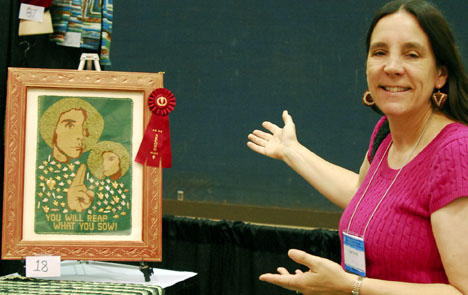
My Harvest tapestry won 2nd place!
I was also able to satisfy my art history appetite by visiting one of the first surviving skyscrapers, the Prudential (Guaranty) Building (Donna and I even got to go inside), and I also visited the Albright Knox Art Gallery. Several paintings and sculptures from my art history classes were on exhibit at the Gallery, so it was really exciting! Nothing like seeing the real thing for the first time!
The day after I flew back from Buffalo, I was on a plane to Ghana – then school started the day after I returned from Ghana. So this has indeed been a busy summer! I love to travel, but it’s really nice to be home again!
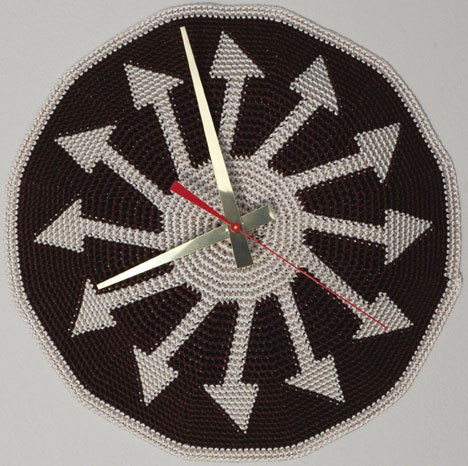
It’s About Time Tapestry Crochet Clock Face, 12 1/4″ diameter
There are two ways to display this timely piece. For the domed look seen above, a clock movement with a regular shaft that uses a size C battery is best, but for the flattened look below, the clock movement needs to have a 1 1/4″ long shaft to raise the hands high enough to clear the fabric. I bought my movement and the 5 3/4″ hands online from clockparts.com.
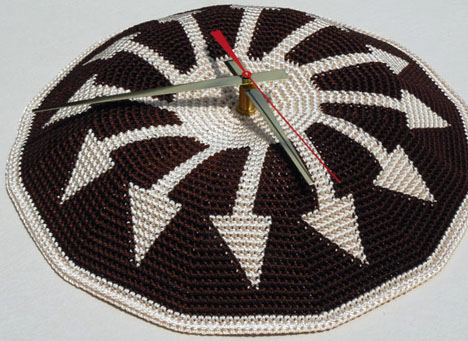
Time’s a wastin’! You need to take your time to give this project a try! (I couldn’t resist the puns – wait a minute – here comes another one!)
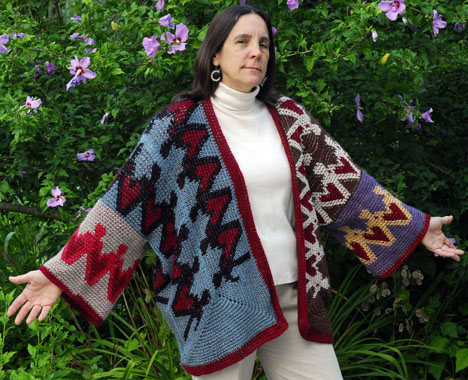
The New World Sweater
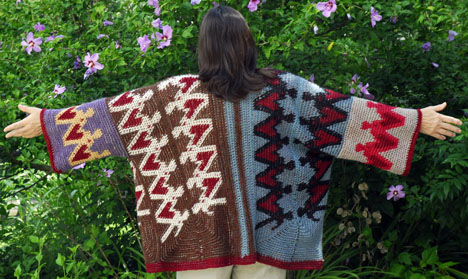
Back view of The New World Sweater.
The instructions for the first version of this project were published in the Winter 2005 Crochet Fantasy. I usually make several versions of a project before submitting it for publication, but the editor requested that I tapestry crochet a coat for the next issue. By the time the yarn arrived, I only had a few weeks to complete it. I crocheted the first panel twice before settling on what you see below, but was sorry that I couldn’t work on it some more before it went to press.
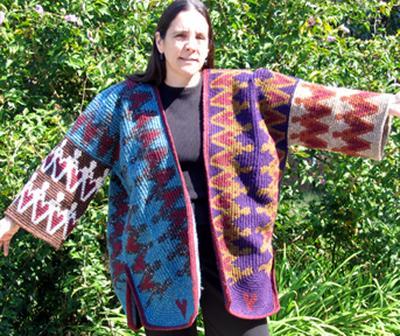
Whole World Coat in Crochet Fantasy, Winter 2005.
The format was inspired by kimono construction. Two long panels were crocheted first, then each was folded in half to create the front and back. After sewing the side seams, the sleeves were crocheted onto the armhole in rounds. After the sleeves were finished, a panel was crocheted to connect the back, the two halves were sewn together, then a border was crocheted around the edge. Three yarns were worked at the same time to create the people motif; two yarns were carried while another was crocheted.
I’m so sorry that Crochet Fantasy went out of business, not only because they encouraged designers to experiment, but they also returned the project and only purchased project instructions for a specific issue, allowing designers to sell the same pattern after the issue was out of print.
This is the most complicated pattern I’ve ever published and unfortunately, I was never paid for it because of the magazine’s demise! Since I still own the copyright, though, I’m able to continue tweaking the instructions and publish the instructions.
For my New World Sweater, I selected a finer yarn – Classic Elite Inca Alpaca instead of Rowan Chunky wool – and a larger hook. I usually get my yarn for free, since it’s good advertisement for the company when the pattern is published, but I bought the alpaca since it would be self published.
Not having a yarn store nearby cost me dearly since the online colors didn’t match the colors I received (colors on computer screens vary a lot!). I had to buy more than twice the amount of yarn needed in order to get colors that would work. The sleeve was especially difficult since I needed a color for the “red” race that contrasted with the red of the hearts. I still wasn’t happy with the heart colors, size, and drape of the second version of the sweater below, though.
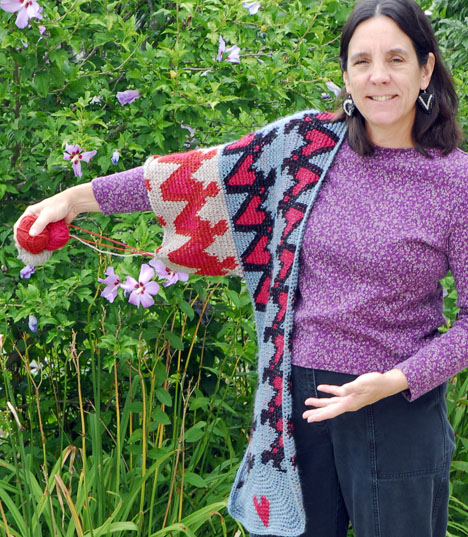
Second version of the Whole World Sweater crocheted with a size K hook and alpaca.
The shorter third version (below left) was crocheted with a size N hook, with chain stitches in the corners to make the panels more rectangular, the single heart at the end of each panel was eliminated, and the rounds were joined with a slip stitch in the center back panel instead of at the corner. I began each round with two chain stitches, but realized later that one chain stitch would have made a less obvious join.
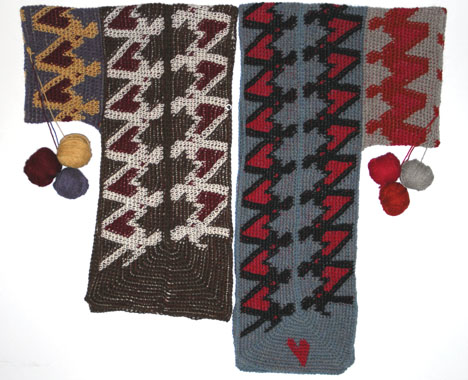
Third and second versions of the New World Sweater.
The sleeve was also adjusted on the third version; two rounds of people would make it too long, so more frogging. The final version has several plain rounds at the top of the sleeve to center a single round of people lengthwise.
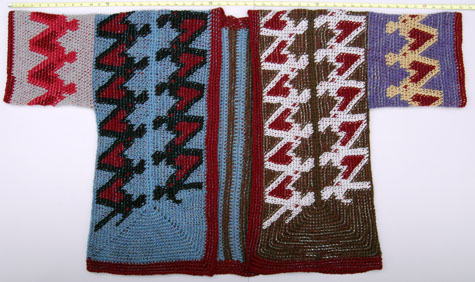
The final version of the New World Sweater.
For a closer look, you’ll be able to see it during the Chain Link Fashion Show next week in Buffalo.
Next time I crochet it, I’ll probably choose an even lighter yarn – perhaps a bamboo blend. Better yet – why don’t you try it with another yarn and let me know how it turns out!
I wasn’t able to attend last year’s conference because it conflicted with my trip to Ghana. I’m going to Ghana again in August, but a few days after returning from Buffalo. In fact, I shortened my Ghana trip to attend the 2009 Conference.
I not only enjoy the conferences, but learn a lot, too! Back in 2007, one of the Professional Development Day panelists asked me why I was attending, but I knew that I still had a lot to learn – and I did. On that day, Kim Werker encouraged me to start this blog during her Internet session (and this is my 65th post)! Lilly Chin prepped us for the media – explaining the importance of preparing catchy phrases and memorable responses ahead of time for when the opportunity presents itself. Rita Weiss and Jean Leinhauser told us what editors wanted. I didn’t realize, for instance, that submissions should include pieces of each yarn used and the yarn labels; that the project should be tagged with both my name and it’s title; that each page of the instructions should include my name, the project title, and the page number; and that some editors prefer to block the pieces themselves!
It’s a lot of work to submit good conference class proposals, then to get everything ready when they’re accepted! A little more work for me this time because I prepared separate instructions for right-handed and left-handed crocheters! I also requested and received free beads, beading needles, yarn, and thread from several generous companies for my classes. I loaded Fire Mountain Gem triangle seed beads onto Patons Classic Wool for my Bead & Felted Tapestry Crochet Cell Phone Ribbon Bag project. Each kit includes $15 of materials, but thanks to the donations, I only need to charge $1!
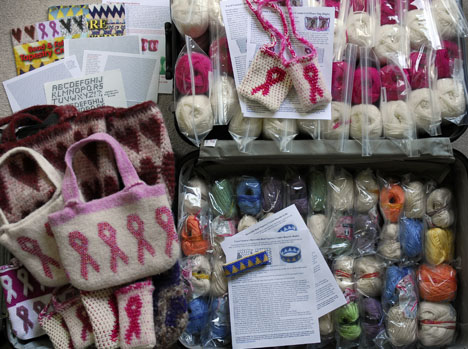
My bags packed with class kits and examples.
Even though my My Bead Tapestry Crochet Cuff Bracelet is scheduled for all day Friday – I still strung Fire Mountain Gems size 8 seed beads onto white and size 6 seed beads onto colorful Aunt Lydia’s Fashion Crochet size 3 crochet cotton to allow everyone more time to finish their bracelet. I always bring along my bead spinner, thread, and beads so that class participants can practice stringing beads, too.
The most time consuming prep was putting together a Powerpoint for my Tapestry Crochet Project and Motif Design class. This interactive presentation includes info from my videos and publications and introduces new material and breaks for tapestry crochet graph paper exercises after each is introduced. I also included the types of images that inspire some of the motifs on my projects – and I look forward to seeing how they will be interpreted by each student!
I’ve sent off my submission for the Design Contest and wrapped my package for the gift exchange. The Design Contest winners will be announced Thursday night, the same night that members exchange a hand crocheted item (maximum $20 of materials). I can’t show you a picture of my package, because it’s a secret! Not everyone exchanges, but I especially love this part of the conference – so I always show up prepared!
I’m not teaching on Saturday, but decided to stay until Sunday to participate in the Fashion Show. Not only to see the runway fashions, but also to look at the fabulous crocheted ensembles and accessories worn by the fashionistas in the audience.
The deadline for preregistration is July 23rd. After that time you can still sign up, but it’s more expensive. Money aside, being surrounded by people who share my crochet passion and being able to match online names to faces is priceless. I hope to see you there – and please say hello, if you are able to make it!
“I was first introduced to crochet at a very young age when I saw my grandmother crocheting. As time went on, I forgot about crochet altogether as crochet is not considered a man’s forte here. It’s mainly considered a woman’s hobby and even with them, crochet is not as popular as it used to be in the past.”
“Crochet items continued to fascinate me but I was still not provoked enough to learn it, until I came across The Blandford Book of Traditional Handicrafts, that had a chapter on crochet and a gallery full of projects that could be made with various handicrafts. This was also my introduction to macrame and a lot of other crafts. But although I wanted to learn crochet, I found it difficult to follow the book’s instructions.”
“Then finally I decided that I should learn from a person and who else was more experienced than Grandma? So I finally learned the basic stitches from her. She taught me how to make a chain and then got me started on single and double crochet.”
“After making small samplers for practice, I came back home and searched online for crochet and saw many different patterns and instructions and started making granny squares and doilies. My internet searches for crochet finally led me to www.tapestrycrochet.com and for the first time I was introduced to tapestry crochet. It looked easy but as I started to make a sample I was very confused as how to turn back after completing one row in flat tapestry crochet, but after much contemplating and help from Dr.Carol Ventura, I was finally able to make the rows from left to right and right to left.”
“The first tapestry crochet I made was the Wrist Warmer in 2003. I always take this wrist warmer with me whenever I go for hiking in the Northern areas. Somehow they seem to belong among the high mountains.”
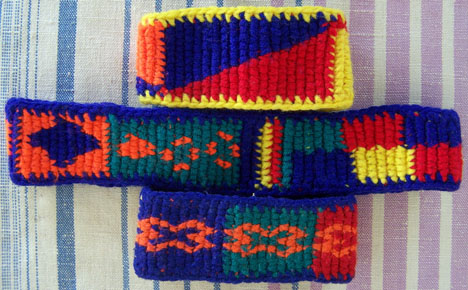
Harry’s acrylic Wrist Warmers, 2003.
“After experimenting with flat tapestry crochet, I was hooked onto round TC after seeing the very beautiful potholders on the Splynda crochet site, which is no longer online.”
“I liked the idea and tried my hand at making pot holders. I made the rocky mountain pattern from her site.”
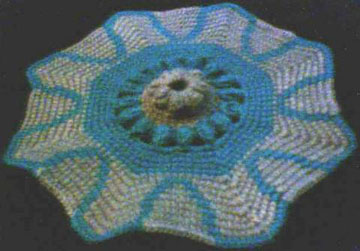
Harry’s Rocky Mountain from a Splynda pattern.
“After that I tried my hand at making a pattern. So I made the dogs facing each other graph, all the while preparing for my annual exams 🙂 I liked the idea of making a net in the centre, surrounded with solid tapestry crochet.”
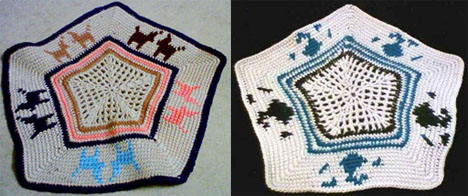
Harry’s cotton pot holders.
“The Llama came as an inspiration and while experimenting with designing the graph, it changed into somewhat of a mythological animal.”
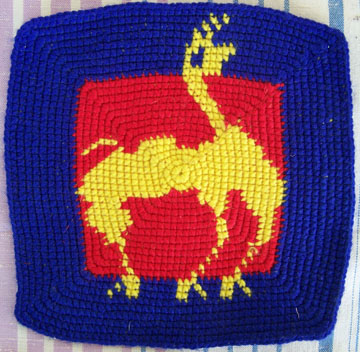
Harry’s acrylic Llama.
“In 2004 I made my first tapestry crochet cap. The pattern of the triangles on the side came from Indian caps which have multi colored sides, too. I first made a flat tapestry crochet strip long enough to go around the head. Then for the upper portion I tapestry crocheted in rounds and made it large enough to cover the head. After that, I joined the two pieces with single crochet and sewed a lining on the inside of the cap.”
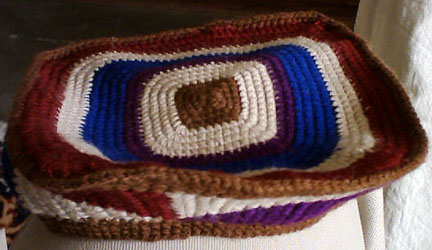
Harry’s first tapestry crochet Cap, 2004.
“After that I grew bold and started making another cap with a more detailed motif on the sides using flat TC. I used the flower motif from the Afghani cross stitch cushion in the center for the other piece.”
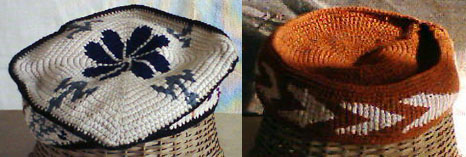
More of Harry’s Caps.
“It was in May 2004 that I started my TC pillow. I was inspired by the Afghani cross stitch pillows (below) and their variety of colors and motifs and planned in my mind how to convert them into TC.
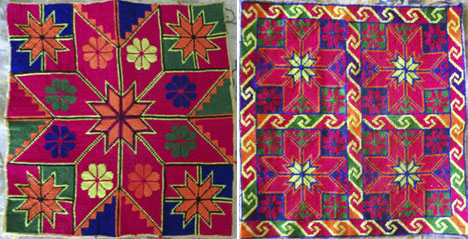
Cross stitch pillow covers from Afghanistan.
“I started it at my hostel, while the summer was at it’s peak and the temperature was above 40 degrees Celsius (104 degrees F). The wool was tough to handle and it wasn’t easy as the pillow grew in size. It took about two weeks working in the afternoons to finish it.”
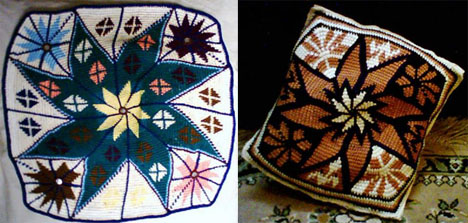
Harry’s acrylic Pillows, based on the Afghani designs.
“In the end, I would like to Thank Dr. Carol who encouraged me at every step to learn tapestry crochet (and backstrap weaving as well) and helped me with her advice and books all these years.”
“I would like to say that with patience and practice everyone can learn tapestry crochet but the important thing is to learn the art of making lives as colorful as the colorful tapestry crochet.”
Harry’s Crafty Threads blog and his Flickr pages showcase more of his eclectic fiber art. And for you Ravelers out there, he’s Harrykhan. He has been away from tapestry crochet for a while, but says, “I intend to finish this piece (below) now which is again based on the same Afghani cross stitch motifs.”
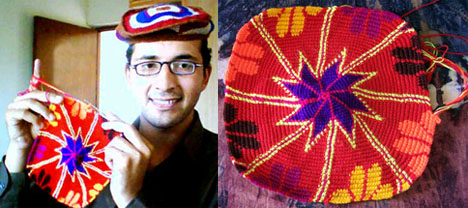
Harry and his WIP tapestry crochet pillow cover.
So what else does Harry do? Well, he’s only one test away from being Dr. Harry. When I told my young daughter years ago that I was studying for my doctorate, she asked if that meant I could take care of her when she was sick. I explained that I was going to be a different kind of doctor – but that I could still take care of her. Harry, on the other hand, will be the type of doctor that takes care of sick people. Based on what I’ve learned about Harry, I suspect his waiting room will be a real visual treat!